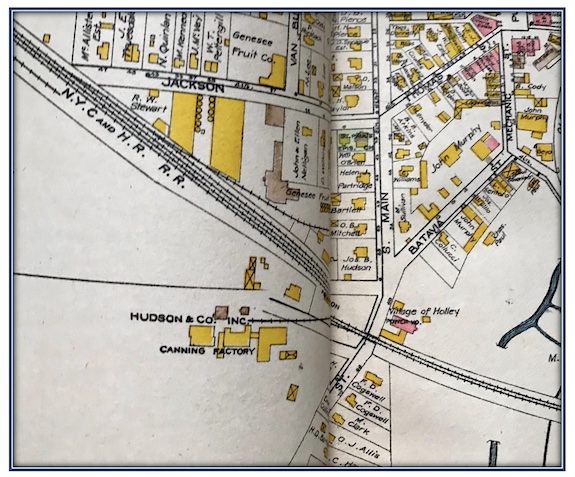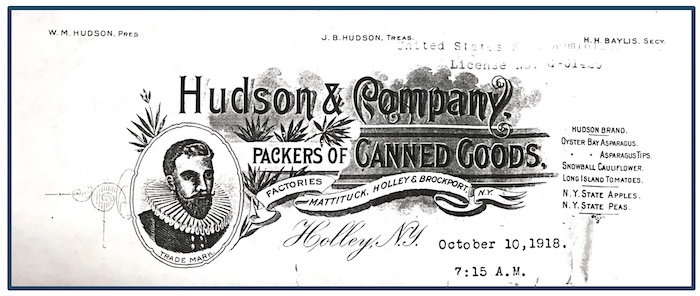Long Island entrepreneur in 1901 built vegetable processing plant in Holley that was later used by Duffy-Mott
By Catherine Cooper, Orleans County Historian
“Illuminating Orleans” – Vol. 4, No. 4
HOLLEY – Business letterheads from the turn of the last century are distinctive for their elaborate designs and ornate fonts. As early examples of branding, they proclaim the nature and tone of the business.
This Hudson & Company letterhead is typical of its era. It includes several curious details:
What does a man wearing an Elizabethan era neck ruff have to do with Holley, NY? Where is Mattituck? What is the connection to Holley, NY? Why are illustrations of laurel plants included in the background?
No doubt, the rendering of the gentleman is intended to represent Henry Hudson, the 17th century English navigator who sailed up the river later named the Hudson in his honor, and who was instrumental in establishing Dutch claims to the area. The portrait establishes a link with the company’s name – Hudson – and with the names of the company officials listed at the top – W.M. Hudson, Pres. and J.B. Hudson, Treas., thereby inferring a longevity to the company.
The laurel can also be explained: Mattituck is a hamlet on Long Island, in Suffolk County and Laurel is the name of the adjoining hamlet. Several area services and businesses combine both names – the Mattituck-Laurel Public Library, for example.
In a 1906 History of Mattituck, Long Island, Rev. Charles E. Craven recorded that William H. Hudson erected a large canning factory in Mattituck in 1888 adjacent to the railroad. It processed large quantities of asparagus, tomatoes, squash and cauliflower.
A severe blight affected Long Island crops in 1896 and for several subsequent years. Seeking to diversify, Joseph Hudson, son of William H. Hudson, relocated to Holley, while his brother, William M., continued the Mattituck operation.
At that time, Holley’s transportation network positioned it to attract manufacturing to the area. A Democrat and Chronicle article credited the Businessmen’s Association of Holley for “securing so valuable an industry for the village.”

Detail of map of the village of Holley from the New Century Atlas of Orleans County, 1913 showing the Hudson Canning Factory and also Joseph Hudson’s home at the corner of South Main Street.
Joseph Hudson bought the Bartlett farm immediately south of the New York Central Railroad, across from Miller and Pettengill’s vinegar and cider plant. Local contractor, John Murphy, started work on the construction of two new buildings for Hudson & Co. on 12 Oct. 1901. The main factory was two stories high and measured 45’x80’. A one-story storage building measured 45’x100’.
The new company proposed to handle as diversified a line of products as possible and to keep the factory in operation seven to eight months of the year. Crops of tomatoes, cherries, apples, peas, and string beans grown by area farmers kept the company busy.
In September 1905, the Democrat & Chronicle reported that “The Hudson canning factory is running full force and is putting out 6,000 – 7,000 cans of tomatoes per day.”
Hudson Canning expanded its western New York presence when it purchased the Batavia Preserving Company plant located in Brockport in 1910. A large silo and vinery were built to process peas at that location. Elbert Johnson, a nephew of Joseph Hudson’s, was appointed superintendent of this plant. (More on Elbert Johnson next week).
Newspapers at that time reported on crop yields and on record crops. In July 1918, Floyd Carr & Son of Ridge Road, just north of the village of Holley, delivered a record breaking 5,870 pounds of shelled peas to the Hudson Canning company. This yield was from four bushels of seeds planted on one acre and “no phosphate was used on the land either.”
Hudson Canning was purchased by Holley Canning in 1932. It was later run by the Comstock Canning Corporation of Newark, NY and subsequently sold to the Duffy-Mott Company in 1951. The Mattituck plant also ceased operation.
A letterhead on file at the Orleans County Dept. of History provided the link to this account of a resourceful family-run enterprise.






































































